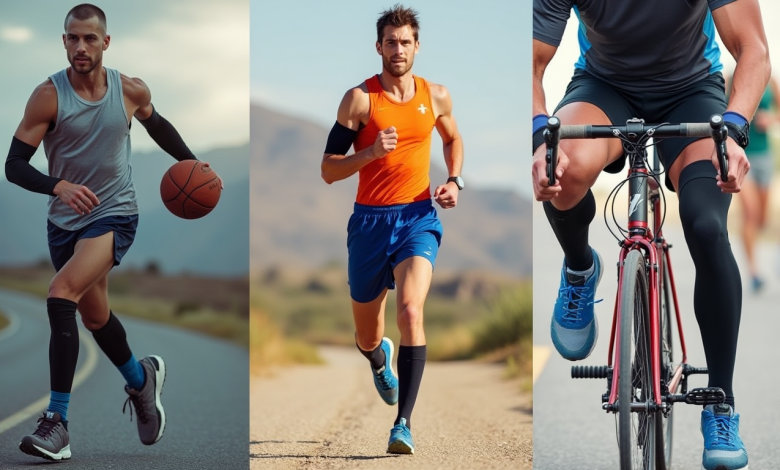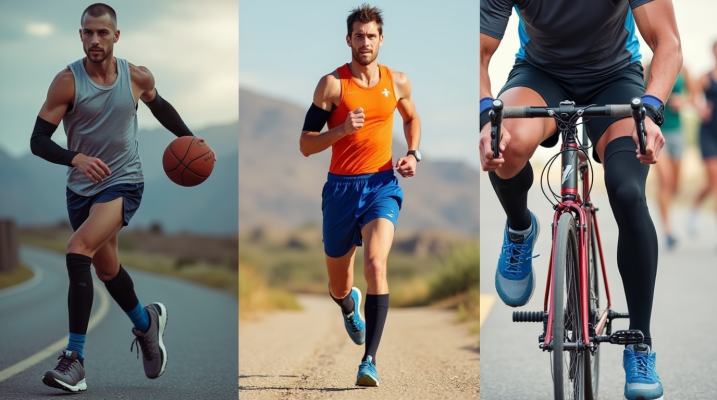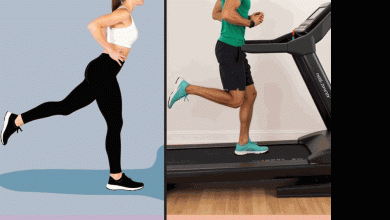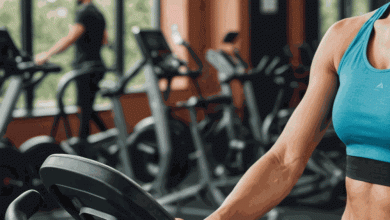Compression Sleeves: The Ultimate Arm Support for Sports and Recovery

Compression sleeves are essential for athletes and individuals engaging in physical activity. They provide support, enhance circulation, and speed up recovery, making them an invaluable accessory for any sport. This article delves into the benefits and types of compression sleeves, offering insights into how to choose the right one for your needs. Discover the best options available in the market, understand the importance of proper fit and sizing, and learn how these products can improve your athletic performance and overall health.
What Are the Benefits of Wearing a Compression Sleeve?
A compression sleeve, whether it’s an arm sleeve or a leg sleeve, offers numerous benefits that can significantly impact your performance and recovery. It helps reduce swelling, promote circulation, and provide support to the muscle. By wearing a compression sleeve, you can enhance your overall performance, prevent injuries, and speed up recovery after a workout or sports activity.
Compression sleeves are designed to provide gentle pressure to the areas of the body, which can help reduce pain and improve comfort. They are often made from breathable and lightweight materials, ensuring that you stay comfortable while wearing them. Additionally, compression sleeves can help prevent blood clots, which is especially important for individuals who spend long periods sitting or standing.
How Do Compression Sleeves Work?
Compression sleeves work by applying graduated compression to the arm or leg, which helps promote circulation and reduce swelling. The gradient compression means that the pressure is highest at the bottom of the sleeve and gradually decreases towards the top. This design helps move blood up the leg or arm, reducing the risk of blood clots and promoting faster recovery.
Compression sleeves can also help reduce muscle vibration, which can lead to muscle fatigue and soreness. By providing support and stability, compression sleeves can help prevent injuries and improve your overall performance during physical activity. The gentle pressure provided by a compression sleeve can also help reduce pain and improve comfort, making it easier to stay focused and perform at your best.
What Are the Different Types of Compression Sleeves?
There are several types of compression sleeves available, each designed for specific purposes. Arm sleeves are often used for sports that involve repetitive arm movements, such as basketball or football. They can help reduce muscle fatigue and provide support to the shoulder and elbow. Elbow sleeves are specifically designed to provide support and stability to the elbow joint, which can be prone to injuries during physical activity.
Compression socks and calf sleeves are often used for sports that involve long periods of standing or sitting, such as running or cycling. They can help reduce swelling and promote circulation in the lower legs. Leg sleeves are also used for sports that involve leg movements, such as soccer or basketball. They can help reduce muscle fatigue and provide support to the knee and thigh.
What Are the Best Compression Sleeve Materials?
The best compression sleeve materials are those that are breathable, lightweight, and durable. Many compression sleeves are made from synthetic fabrics, such as nylon or polyester, which are durable and resistant to moisture. These materials are also breathable, allowing air to flow through the fabric and keep you comfortable while wearing the sleeve.
Some compression sleeves are made from copper-infused fabrics, which are said to have antimicrobial properties and can help reduce odor. Other compression sleeves are made from silicone, which is gentle on the skin and can help reduce friction. The choice of material will depend on your specific needs and preferences.
What Is the Best Color for a Compression Sleeve?
The best color for a compression sleeve is one that you feel comfortable wearing and that complements your personality and style. Many compression sleeves come in a variety of colors, including black, gray, and white, as well as bright colors such as red, blue, and green. Some compression sleeves even come in camouflage or team colors, making them a great option for sports enthusiasts.
When choosing a color, consider the purpose of the sleeve. If you’re using it for sports, you may want to choose a color that complements your team uniform or stands out on the field. If you’re using it for recovery, you may want to choose a color that is comfortable and relaxing.
What Size Compression Sleeve Should I Wear?
The size of the compression sleeve you should wear depends on your arm or leg measurements. Most compression sleeves come in a range of sizes, from small to extra-large, so it’s important to measure your arm or leg accurately to ensure a proper fit. A compression sleeve that is too loose will not provide the necessary support, while a compression sleeve that is too tight can be uncomfortable and may even cause pain.
When measuring your arm or leg, make sure to measure at the widest point. For an arm sleeve, this will typically be at the bicep. For a leg sleeve, this will typically be at the thigh. It’s also important to consider the length of the sleeve you need. Some compression sleeves are designed to cover the entire arm or leg, while others are designed to cover only a specific area, such as the calf or thigh.
What Are the Best Brands for Compression Sleeves?
There are many brands that offer high-quality compression sleeves, each with their own unique features and benefits. Some of the best brands for compression sleeves include Juzo Soft, Juzo Dynamic, Zensah, and Pro Compression. Juzo Soft and Juzo Dynamic are known for their durable and comfortable compression garments, while Zensah is known for its advanced technology and design.
When choosing a brand, consider your specific needs and preferences. Some brands may offer compression sleeves with specific features, such as copper-infused technology or silicone fabric. Other brands may offer a wider range of sizes and colors to choose from. It’s also important to consider the price point and the reputation of the brand.
Can Compression Sleeves Be Used for Medical Conditions?
Compression sleeves can be used for medical conditions, such as lymphedema or vein issues. Lymphedema is a condition that causes swelling in the arm or leg due to a buildup of lymph fluid. Compression sleeves can help reduce swelling and improve circulation, which can be beneficial for individuals with lymphedema. Similarly, compression sleeves can help reduce swelling and promote circulation in the veins, which can be beneficial for individuals with vein issues.
Compression sleeves can also be used for recovery after surgery or injury. They can help reduce swelling and promote circulation, which can speed up the recovery process. However, it’s important to consult with a medical professional before using a compression sleeve for a medical condition to ensure that it is the right option for you.
How Do I Choose the Right Compression Sleeve?
Choosing the right compression sleeve depends on your specific needs and preferences. Consider the type of activity you will be doing, the areas of the body you need support for, and the level of compression you require. You should also consider the material, color, and size of the sleeve. Some compression sleeves may also come with additional features, such as a gauntlet or a silicone grip, which can provide additional support and stability.
When choosing a compression sleeve, it’s also important to consider the fit and comfort. A compression sleeve that is too loose or too tight can be uncomfortable and may not provide the necessary support. It’s also important to consider the price point and the reputation of the brand. Some brands may offer a wider range of sizes and colors to choose from, while others may offer specific features that are important to you.
What Are the Latest Trends in Compression Sleeves?
The latest trends in compression sleeves include the use of advanced technology and design, as well as the use of copper-infused fabrics. Many brands are now offering compression sleeves with copper-infused technology, which is said to have antimicrobial properties and can help reduce odor. Other brands are using advanced technology to create compression sleeves that are more comfortable and breathable.
Another trend in compression sleeves is the use of silicone grips, which can provide additional support and stability. Some brands are also offering compression sleeves with unique designs, such as camouflage or team colors, making them a great option for sports enthusiasts. The use of flat knit technology is also becoming more popular, as it can provide a more comfortable and breathable fit.
- Compression sleeves offer numerous benefits, including reducing swelling, promoting circulation, and providing support to the muscle.
- Compression sleeves work by applying graduated compression to the arm or leg, which helps promote circulation and reduce swelling.
- There are several types of compression sleeves available, including arm sleeves, elbow sleeves, compression socks, and leg sleeves.
- The best compression sleeve materials are those that are breathable, lightweight, and durable.
- The best color for a compression sleeve is one that you feel comfortable wearing and that complements your personality and style.
- The size of the compression sleeve you should wear depends on your arm or leg measurements.
- Some of the best brands for compression sleeves include Juzo Soft, Juzo Dynamic, Zensah, and Pro Compression.
- Compression sleeves can be used for medical conditions, such as lymphedema or vein issues, but it’s important to consult with a medical professional before using a compression sleeve for a medical condition.
- Choosing the right compression sleeve depends on your specific needs and preferences, including the type of activity, areas of the body, level of compression, material, color, size, and fit.
- The latest trends in compression sleeves include the use of advanced technology and design, copper-infused fabrics, silicone grips, unique designs, and flat knit technology.



